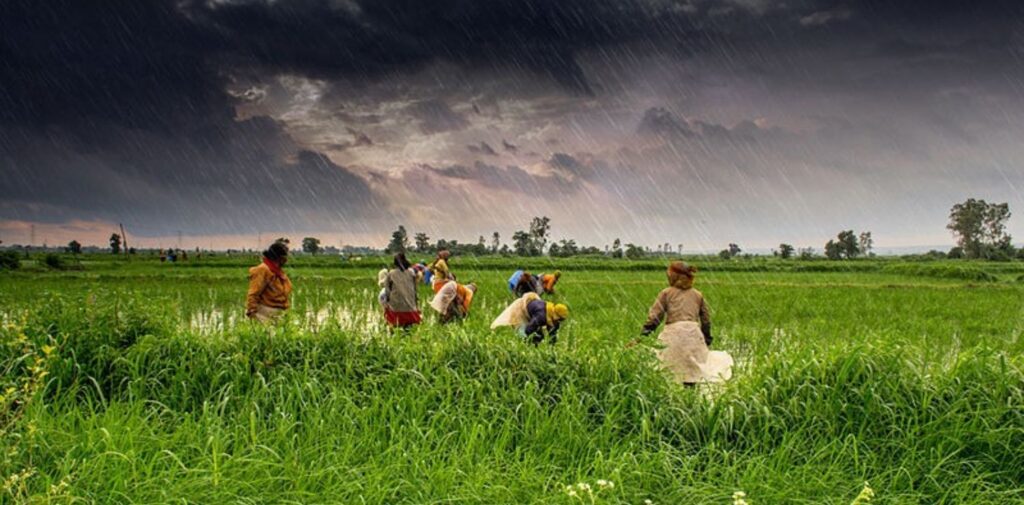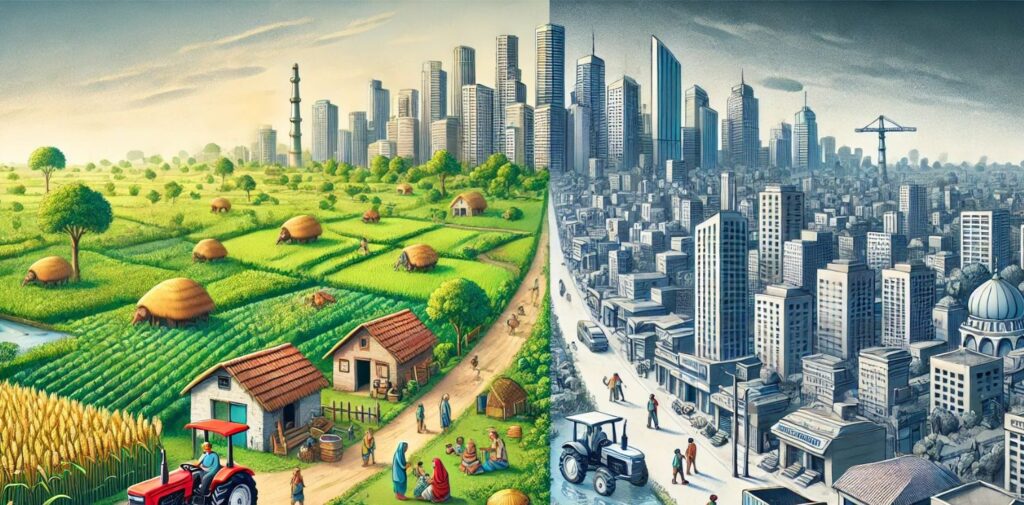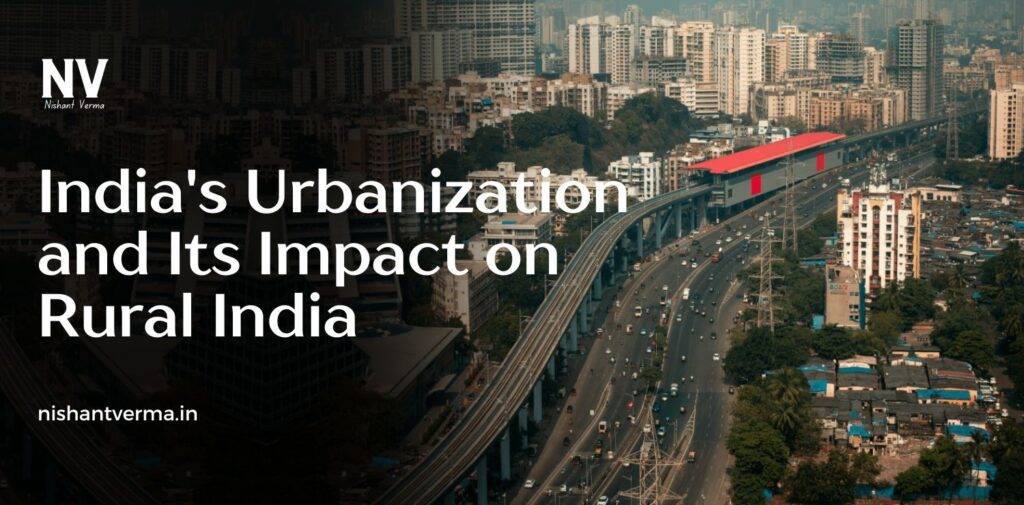India is undergoing one of the largest urbanization processes in the world. Cities are growing at an unprecedented rate, and more people are moving from rural areas to urban centers in search of better opportunities. While urbanization brings a host of benefits to cities, it has significant effects on rural India, which continues to house the majority of the country’s population. This article explores the impact of urbanization on rural India, including the challenges it brings, the opportunities it offers, and the measures needed to balance the growth of urban and rural areas.
The Growth of Urban India
Over the last few decades, India’s urban population has been rapidly increasing. According to the 2011 Census, about 31% of India’s population lived in urban areas, but by 2021, this number was expected to rise to over 35%. The growing trend is due to several factors, such as better employment opportunities, improved infrastructure, access to education, and better healthcare in cities. Cities like Mumbai, Delhi, Bangalore, and Hyderabad have become the epicenters of economic growth, attracting people from all over the country.
Urbanization also creates a ripple effect, encouraging the development of satellite towns and smaller cities. However, this surge in urban populations has also led to problems such as overcrowding, pollution, and a strain on infrastructure and public services. The push towards urbanization has created a stark divide between urban and rural areas, affecting the social and economic fabric of rural India.

Migration: The Push and Pull Factors
The primary reason for the rural-to-urban migration is the search for better economic opportunities. Many rural areas in India still rely heavily on agriculture, which is often dependent on factors like the weather and market conditions. Agriculture in rural India is plagued by issues like low productivity, lack of proper irrigation facilities, inadequate access to modern farming tools, and poor market linkages. As a result, many farmers and young people in rural areas look for work in cities, hoping for better prospects.
On the other hand, urban areas offer higher wages, better infrastructure, improved access to education and healthcare, and a broader range of employment opportunities. Over time, the rural population moves towards cities in search of better livelihoods, leaving behind an increasingly younger and smaller rural population. This migration has led to rural depopulation, which has direct consequences on agriculture, local economies, and social structures in these areas.
Impact on Rural Agriculture and Economy
One of the most significant impacts of urbanization on rural India is on agriculture. With the migration of the younger and working-age population, rural areas face a shortage of labor for agricultural work. This leads to a decline in agricultural productivity, which is already facing challenges such as water scarcity, climate change, and lack of modern technology. Many agricultural lands are left uncultivated or are not maintained as effectively as they could be.
Furthermore, the focus on urban growth diverts attention and resources away from rural areas, resulting in underdeveloped infrastructure such as poor roads, inadequate irrigation systems, and limited access to market facilities. These issues make it harder for rural farmers to sell their produce at competitive prices and lead to a reliance on middlemen, reducing their profits. The shrinking rural workforce and poor infrastructure contribute to the stagnation of rural economies, creating a vicious cycle of poverty and underdevelopment.

Social Challenges in Rural India
As rural areas continue to lose their younger population, the social fabric of these regions also begins to change. The migration of young people in search of better opportunities leaves behind an aging population. This demographic shift leads to challenges such as the lack of social support for elderly individuals, as the younger generation has moved away to urban centers.
Additionally, the rural-urban divide has led to differences in access to education and healthcare. Urban areas tend to have better schools, colleges, hospitals, and other facilities, which makes them more attractive to people. In contrast, rural areas often struggle with a shortage of skilled teachers and healthcare professionals, limiting access to essential services for the rural population. This inequality has a long-term impact on the quality of life in rural areas and can perpetuate cycles of poverty.
Urbanization and Rural Development: Opportunities and Solutions
While urbanization has caused challenges for rural India, it has also brought some opportunities for rural development. As cities grow, there is an increasing demand for products and services from rural areas. For instance, urban areas rely on rural regions for agricultural produce, textiles, and raw materials. This interdependence has the potential to create new markets for rural businesses and entrepreneurs.
Rural areas can also benefit from the technology and skills that are transferred from urban centers. The rise of digital connectivity and mobile phones has brought new opportunities for rural businesses, farmers, and small-scale industries to connect with national and global markets. Initiatives such as Digital India have enabled rural people to access government services, banking, and information related to agriculture and health more efficiently.
Furthermore, the government and private sectors have begun to recognize the need to address rural challenges. There have been efforts to promote rural entrepreneurship and skill development programs to empower rural youth. Through initiatives like Make in India and Skill India, rural people are being trained in various trades and industries, providing them with better job opportunities both in urban and rural settings. With improved connectivity, rural businesses can also access larger markets and supply chains, which can help boost local economies.

Balancing Urban Growth and Rural Development
The key to addressing the challenges of urbanization lies in creating a balanced approach to urban and rural development. While urban areas must continue to grow and flourish, the rural areas also need attention and investment to ensure that the benefits of economic growth are spread equitably across the country.
First and foremost, the government must continue investing in rural infrastructure such as roads, electricity, water supply, healthcare, and education. These investments will help make rural areas more attractive for residents and encourage people to stay rather than migrate to cities. Additionally, policies that promote sustainable agriculture, better access to markets, and the use of technology in farming will ensure that rural economies remain productive and competitive.
Another important aspect is to promote decentralization and develop smaller towns as alternatives to major cities. By creating better infrastructure, employment opportunities, and public services in smaller towns, the pressure on megacities can be alleviated, and more people will be encouraged to stay closer to their rural roots. This can also help in reducing overcrowding, pollution, and the strain on urban resources.
Finally, it is important to ensure that rural residents benefit from the growing digital economy. With access to digital platforms, rural businesses can access global markets, education, and health services, helping bridge the gap between urban and rural India. Therefore, promoting digital literacy and infrastructure in rural areas will be crucial for their future development.
Conclusion: India Urbanization
India urbanization presents both challenges and opportunities for rural India. While rural areas face economic, social, and infrastructural challenges due to urban migration, urbanization can also provide avenues for rural development if properly managed. A balanced approach that promotes rural growth, alongside urban expansion, will ensure that both urban and rural areas thrive together.
The key to a sustainable future for India lies in addressing the needs of rural areas through investments in infrastructure, technology, and education. With the right policies and initiatives, rural India can benefit from urbanization while maintaining its cultural and economic relevance in the nation’s growth story. By focusing on creating equal opportunities for both urban and rural populations, India can pave the way for a more inclusive and prosperous future for all its citizens.




